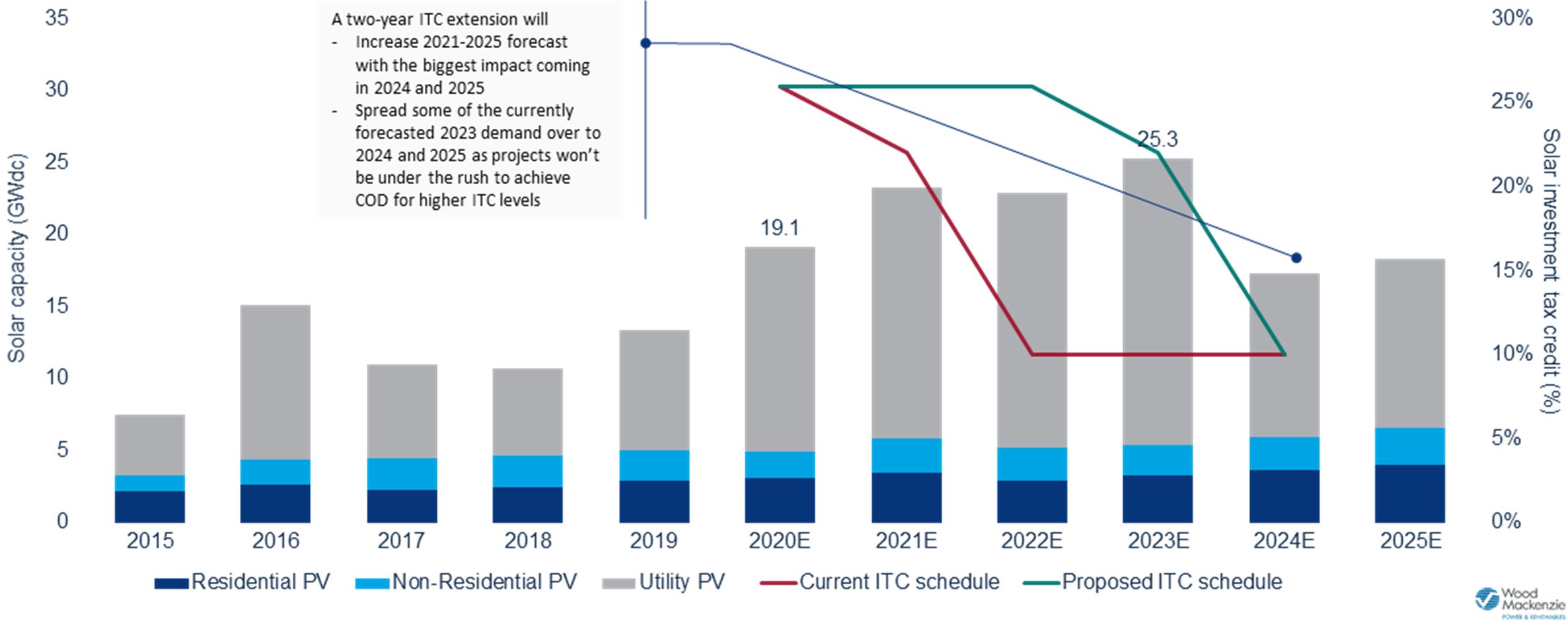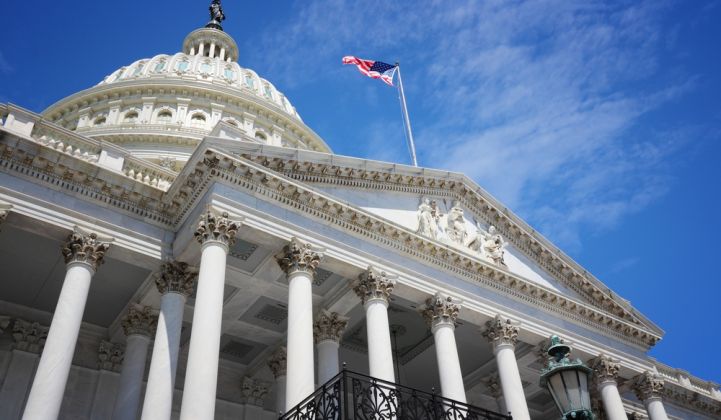The U.S. Congress on Monday passed a massive spending bill that includes $35 billion in energy research and development programs, a two-year extension of the Investment Tax Credit for solar power, a one-year extension of the Production Tax Credit for wind power projects, and an extension through 2025 for offshore wind tax credits — a significant last-minute boost for clean energy industries.
These clean energy provisions are included in a $1.4 trillion federal spending and tax extension package negotiated by congressional leaders over the weekend alongside a $900 billion coronavirus relief package. Summaries of the energy provisions included in the bill were provided by the office of Senate Minority Leader Charles Schumer (D-New York), and Schumer and House Speaker Nancy Pelosi (D-Calif.) highlighted them in a Sunday summary of the legislation's contents.
Congress is under pressure to pass both bills Monday to ensure continued funding of the federal government and complete a politically pressing extension of coronavirus pandemic relief measures passed in March. UPDATE: The final version of the legislation was passed by the House of Representatives and the Senate on Monday evening.
The energy research, development, demonstration (RD&D) and commercialization funding in the bill is the first major energy legislation passed in a decade. While it does not mandate carbon emissions reductions sought by the Biden-Harris administration, it directs billions of dollars over the next five years to support technology improvements in solar and wind power, energy storage, geothermal power, marine energy, grid modernization, energy efficiency, nuclear power, and carbon capture, utilization and storage.
This research and development spending will have a limited impact on incentivizing the near-term growth of renewable energy. But the tax-credit extensions contained in the bill will provide a significant boost for the primary federal incentive structure for wind and solar power by extending the expiration dates set by Congress late last year.
The extensions will be welcome relief for renewable energy industries that have pointed to coronavirus-related economic disruptions as threatening to delay projects and reduce their value. They could also set the industries in a more advantageous position to seek further federal policy support as President-elect Joe Biden takes office and seeks to implement ambitious decarbonization goals for the U.S. energy sector, said Ravi Manghani, head of solar research for Wood Mackenzie.
The solar and wind industries were unable to secure a “direct-pay” provision they had sought to allow tax credits to be converted into direct payments from the federal government, rather than needing to be claimed by investors seeking to offset tax liability. Developers in the space are concerned that the coronavirus pandemic’s impact on the economy will depress demand for tax equity investments, as banks and financial institutions will have less appetite for credits to offset tax liabilities in a year when profits were depressed.
Solar tax credit impacts
According to a summary shared by Sen. Schumer’s office, the two-year extension of the federal Investment Tax Credit for solar projects will retain the current 26 percent credit for projects that begin construction through the end of 2022, rather than expiring at the end of 2020 as they would have under existing law. The ITC will fall to a 22 percent rate for projects that begin construction by the end of 2023, and then fall to 10 percent for large-scale solar projects and to zero percent for small scale solar projects in 2024.
Many of the large-scale solar development set to be completed through 2023 have used "safe-harbor" provisions to secure the original 30 percent ITC credit, removing the risk of seeing project financing disrupted by a reduction in the tax credits, Manghani noted.
But a two-year extension is “a much better outcome than the industry had expected,” Manghani said. It will provide significant upside to solar growth in 2022 through 2025, as more projects can secure the 26 percent and 22 percent credits through "commence-construction" or "safe-harboring" provisions by 2023.

What’s more, the bill “provides the industry a full extra year to negotiate longer-term tax credits or tie renewables directly with future carbon policies with the friendly Biden administration,” Manghani noted. Utility-scale solar power is already cost-competitive against coal-fired power across the world and with natural-gas-fired power in many markets.
The lack of a direct-pay provision "may be a bit disappointing for the smaller solar developer shops that have had a tough time securing tax equity capital in the pandemic-induced [economic contraction],” Manghani conceded. But, he added, “all in all, the industry will reflect on this outcome as a glass three-quarters full.”
Wind tax credit impacts
Wind power will also benefit from the tax extensions provided for in the bill. The Production Tax Credit for wind power projects, usually claimed by onshore developers, will remain at 60 percent for projects that begin construction by the end of 2021, rather than being reduced to 40 percent as called for in previous law. Absent any future changes in law, the PTC will be reduced to zero starting in 2022.
Action by the U.S. Treasury earlier this year extended safe-harbor provisions an extra year to make allowance for coronavirus-related project slowdowns, which offered relief for projects struggling with disruptions to supply chains and permitting and construction delays.
Offshore wind will gain significant tax benefits as well, through the extension of the ITC that can be used in lieu of the PTC for funding wind projects. Under previous law, any wind project seeking to use this ITC option would have seen its availability expire completely as the PTC is wound down over the coming two years.
But the new ITC rules will allow offshore wind projects to retain access to a full 30 percent credit for projects that begin construction through 2025. That’s a major new boost for the estimated 28 gigawatts of offshore wind projects being planned for the U.S. East Coast through 2030, some of which have been forced to push back completion dates due to delays in federal permitting that could threaten access to higher levels of tax credits.
"State governments and utility ratepayers will be able to take advantage of lower delivered energy costs as a result of the extension," Dan Shreve, WoodMac's head of global wind research, said in an email. "More states should be emboldened to join ranks with states that have adopted ambitious offshore wind mandates to support decarbonization of their power grids." The extension will also help provide certainty for developing offshore wind manufacturing and port facilities, he said.
R&D for clean energy, energy storage, carbon capture and nuclear power
Sen. Schumer’s office also shared details of the Energy Act of 2000, a massive energy RD&D funding package brought into the broader spending package last week. The bill contains about $35 billion in funding over the next five years across Energy Department programs, through a collection of programs largely stemming from the 555-page Senate energy bill introduced this spring by Senator Lisa Murkowski (R-Alaska) and Senator Joe Manchin (D-West Virginia), as well as an accompanying energy bill passed by the House this spring.
Solar power will get $1.5 billion for programs to improve solar PV energy efficiency and cost-effectiveness, boost solar panel manufacturing and recycling, and better integrate solar power into the grid. Wind power will get $625 million to fund materials and design research, manufacturing and deployment efficiency improvements, and technologies to integrate wind power at the transmission grid and distribution grid scale. Geothermal energy research will get $850 million, and hydropower and marine power will get $933 million.
Along with these RD&D funds, the act will direct the Interior Department to set a target of at least 25 gigawatts of solar, wind and geothermal production on public lands by 2025, according to the summary. The Biden administration intends to streamline permitting and lower costs of developing renewable energy on public lands, as well as reverse Trump administration policies that have allowed expanded oil and gas drilling on public lands.
Energy storage will receive $1.08 billion over five years in funding for the research and commercialization of a range of technologies needed to integrate intermittent renewables into the grid. Targets include multihour-duration distributed batteries and control systems to manage their interaction with the grid, plus long-duration storage technologies such as pumped hydro and compressed-air energy storage.
Another $2.36 billion over five years will be directed toward a range of grid modernization efforts, ranging from integration of renewables, batteries and electric vehicles to model grid architectures to guide the technology standards and control platforms to manage these assets. The funding will also support cybersecurity investments, a critical issue given the recent news of Russian-led hacks of IT systems at DOE and the Federal Energy Regulatory Commission, as well as U.S. utilities and energy companies.
Carbon capture, utilization and storage will be targeted with $6.2 billion to reduce emissions at power plants, and $477 million will support research into technology that can capture carbon dioxide from the air. Another $500 million will fund carbon-emissions reduction research for hard-to-decarbonize industrial sectors like steel and cement manufacturing and transportation sectors like shipping and aviation.
Nuclear power will receive $6.6 billion for modernizing nuclear power plants and develop advanced reactor designs, and $4.7 billion will be used to fund basic and applied research into nuclear fusion.
And to speed research and commercialization across multiple energy technology sectors, DOE’s ARPA-E program will receive $2.9 billion in funding.




